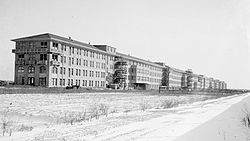Edward Hines, Jr. VA Hospital
|
Edward Hines Jr. Veterans Administration Hospital Historic District
|
|

Main Infirmary Building shortly after construction
|
|
| Location | 5000 South 5th Avenue, Hines, Illinois |
|---|---|
| Coordinates | 41°51′40″N 87°50′29″W / 41.86111°N 87.84139°WCoordinates: 41°51′40″N 87°50′29″W / 41.86111°N 87.84139°W |
| Area | 45 acres (18 ha) |
| Architect | Schmidt, Garden and Martin; H. B. Wheelock |
| Architectural style | Colonial Revival, Neoclassical |
| NRHP Reference # | 13000814 |
| Added to NRHP | October 9, 2013 |
The Edward Hines Jr. Veterans Administration Hospital is a second-generation Veterans Health Administration hospital in Hines, Illinois, United States. It currently encompasses 174 acres (70 ha) on its campus and leases an additional 60 acres (24 ha) to the Loyola University Medical Center.
Construction began in 1918 on land donated by the Edward Hines Lumber Company that was originally Speedway Park, a board track racecourse. Originally intended to house casualties from World War I, Hines wanted the building to serve as a hospital after the war. Hines was successful in lobbying the United States Congress to take over the facility as a veterans hospital in 1920. Since the first patient was admitted on August 8, 1921, Hines has been a leader in the Veterans Affairs network and has partnered with five medical schools to develop a comprehensive residency program. In 2013, 45 acres (18 ha) of the campus, including the Old Airmail and Postal Service Buildings from the Maywood Air Mail Field, were listed on the National Register of Historic Places as a historic district.
The history of the property in Hines, Illinois began in 1835, when the land was sold to Frederick Bronson by the United States government. The land was used for farming until 1914, when the Speedway Park Association purchased the 320-acre (130 ha) lot to develop a race track. The organization built a 2-mile (3.2 km) oval wooden track on the land and held races starting in June 1915. The track was one of the longest board tracks in the United States. The course was host to a number of national and international racing competitions featuring competitors such as Barney Oldfield, Ralph DePalma, Louis Chevrolet, and Dario Resta. The track was initially very successful, attracting as many as 45,000 spectators. However, the entry of the United States into World War I in April 1917 doomed the financial viability of the racetrack. It was one of the first board tracks to close; most board tracks in the United States were closed by the end of the 1930s.
...
Wikipedia


